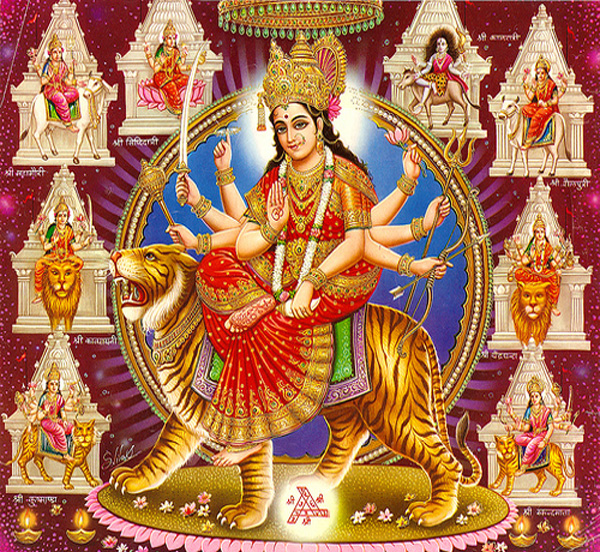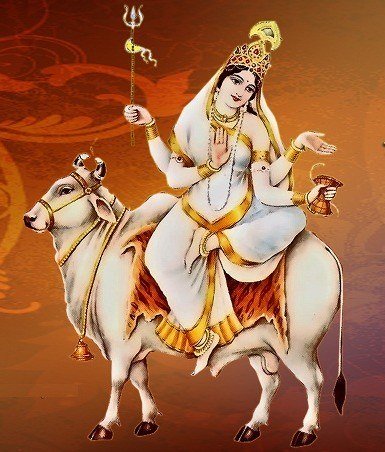Nine forms of Goddess Durga
Durga has many arms. She is sometimes depicted as having ten arms and sometimes as eighteen arms. Her radiant face and beautiful form wrapped in royal red has a bewitching appeal. Durga can be benign and wrathful at the same time. The ten days starting from the new moon day in the month of Ashwin is the most auspicious period in the Hindu calendar. Navaratri is perhaps the only Hindu festival celebrated all over India with equal fervor. While each state celebrates Navaratri in their unique way, they all have one common theme – the victory of good over evil.

Various manifestations of Goddess Durga
The nine days of Navaratri celebrate the nine forms of the Goddess. The nine Durgas worshipped on the nine days of Navaratri are:
Shailaputri (Daughter of Mountain)
Shailaputri means the daughter of the mountains. She is the first among nine Durgas and is popularly called Parvati. She is the daughter of Himavan (Himalaya) and the consort of Shiva. In her previous birth she was called Sati (the chaste one). Sati was the daughter of King Daksha. From a very young age Sati started worshiping Shiva. She wanted to marry him; however, her father didn’t approve of this marriage. Daksha didn’t want his beautiful daughter to marry Shiva who dwells in the inhabitable terrains of Mount Kailash, smears ashes all over his body, wears skulls around his neck and wraps himself in a piece of elephant skin. Sati, nonetheless, married Shiva against the wishes of her parents. Years went by. Sati, a devoted and chaste wife, was perfectly happy with Shiva.
Once her father Daksha organized a big Yagna (a kind of sacrifice involving fire). He invited everyone except his daughter and son-in-law. Sati wanted to participate in the Yagna. Shiva advised her against going to her paternal home; however, she persisted and went. Her father was not happy to see her and started insulting Shiva in front of everyone. Unable to bear the insult meted out to her husband, Sati immolated herself in the fire of Yagna. When Shiva realized that his wife had killed herself, his anger and sorrow knew no bounds. He promptly reached Daksha’s palace and carrying his wife’s charred body, he performed Tandava (the celestial dance of destruction). His Tandava wreaked havoc all over the world. Thereafter he pulled two locks of hair and threw them on to the ground. From one arose dark complexioned Virbhadra, the terrible incarnation of Shiva. From the other arose Bhadrakali (also dark), the fierce incarnation of Sati or Shakti. Virbhadra and Bhadrakali decapitated Daksha.
As Shiva continued his dance of destruction, gods and sages fell at his feet. The all-forgiving God finally cooled down and restored all those who were slain to life and blessed them. Still, grief-stricken he roamed around the world carrying his wife’s mortal remains like a lunatic. Shiva’s renunciation from worldly affairs created a lot of problems and to get him involved in the cosmic drama again, Lord Vishnu cut Sati’s body into 52 pieces with his Sudarshan Chakra. The places where her body parts fell became Holy places of worship called Shakti Peeths. Shiva himself summoned Virbhadra to assist in the construction of these temples. After a long interval, Sati was reborn as Parvati and eventually got reunited with Shiva.
Brahmacharini
Brahmacharini is the second of the nine Durgas. This is the form of the Goddess that observes penance or Tapa. There is a famous story about this Goddess. She is actually Parvati, the daughter of Himavan. Once when little Parvati was busy playing with her friends, sage Narada approached her. Reading the lines of her palm, he predicted that she would marry a naked ‘Bhole Baba’ (another name of Shiva) with terrible attributes. He told her that she was married to him in her previous birth as Sati. Narada advised her to perform penance to win the favor of this Bhole Baba. Parvati promptly approached her mother and told her that she would marry none except Shambu (another name of Shiva) and went to the forest to perform penance. This is how she obtained the name Brahmacharini or Uma.
Chandraghanta
She is the third of the nine Durgas. She wears a semicircular moon on her forehead. She rides a lion and looks cheerful and radiant. She has three eyes and ten arms holding various weapons. She is a warrior Goddess.
Kushmanda
She is the fourth of the nine Durgas. Her smile brightens the entire universe. She has eight arms. She carries rosary in her right hand and weapons in seven arms. Goddess Kushmanda likes the offerings of “Kumhde.”
Skanda Mata
The fifth form of Goddess Durga is called Skanda Mata (mother of Skanda). She is another form of Parvati. After getting married to Shiva, Parvati had a son called Skanda. Skanda Mata is the deity of fire. She has four arms and three eyes. She is fair.
Katyayani
Katyayani is the daughter of sage Katyayan. He wanted Adi Parashakti (the Supreme Goddess) to be born as his daughter and observed rigorous penance. The Goddess was pleased with his devotion and took birth as his daughter. Goddess “Katyayani” has three eyes and eight hands. She rides a lion.
Kalratri
The seventh form of Durga is known as Kalratri. She is as black as night. Her hairs are unlocked and she has a fierce appearance. Her eyes are round and bright. When she breathes out thousands of flames come out of her nostrils. She rides on Shava (dead body). She carries a sharp sword in her right hand and blesses her devotees with her lower right hand. Her fierce form makes her devotees fearless.
Maha Gauri

Maha Gauri
Gauri is the eighth of the nine Durgas. She is as white as a jasmine flower or moon. She is an eight year old beautiful girl wearing clean and white clothes and ornaments. She has three eyes and four arms. She rides a bull. She has a calm radiance and fills peace in the mind of her devotees. There is an interesting story about Gauri. She is little Parvati who observed penance in the forest to win the love of Shiva. The penance had made her fragile and her fair skin had become dark from the dust and dirt in the forest. It is believed that impressed with her devotion, Shiva made her body clean and fair again by pouring the holy waters of Ganga on her. Thus she became bright like lightening. This is how she earned the name Gauri which means fair in Sanskrit.
Siddhidatri
The ninth Durga is called Siddhidatri. Siddhidatri is the giver of Siddhi (skills). It is believed that Shiva got his skills by worshiping Maha Shakti. That’s why he is often portrayed as Ardhanariswar. The Ardhanariswar form of Shiva and Shakti has half of their bodies fused together. This concept proves beyond doubt that male and female energies need to stay united to gain success and bliss. Shiva is powerless without his consort Shakti. The Siddhidatri form of Durga is worshipped by all sages, gods and devotees who seek blessings and skills.